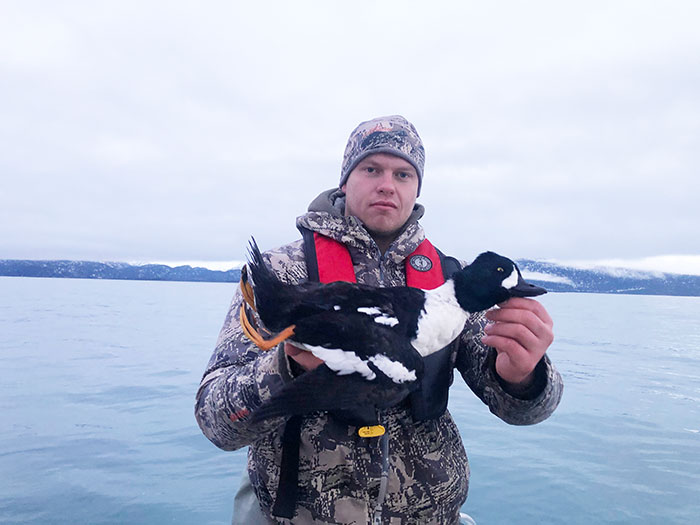Hunting Homer Waterfowl
Blog & Photos by Garrett Baeten

A happy hunter with a perfect Barrow’s goldeneye drake.
I wasn’t sure what to expect as we motored out of the Homer harbor as daylight began to break across Kachemak Bay on December 7th, 2020. A light rain accompanied the dawn with a chilled 32-degree breeze that caused a slight chop on the water. As I looked across Kachemak Bay to the south of Homer toward the mountains, I could only imagine laying eyes on the iconic sea ducks that Alaska is known for, such as my personal prize bird—the harlequin—but I also had thoughts of seeing scoters and Barrow’s goldeneyes. The half-hour boat ride across the bay seemed to take an eternity until we finally reached the hunting grounds. I was hunting with Jay Sjogren and Pete Fenske, both Minnesota transplants. Jay has hunted birds in Alaska for years and was more than willing to help me get a harlequin for the wall and also to get Pete on a good duck shoot.

A pair of harlequins fresh off the water and destined for the taxidermist.
Waterfowl hunting has always been a favorite pastime of mine since growing up in Wisconsin, hunting puddle ducks and diver ducks on Green Bay. I read the stories of hunters taking off to Alaska to hunt birds in the Aleutian Islands, Kodiak Island, and Homer. These stories and photos were another inspiration to drop decoys in the waters of Kachemak Bay for my own opportunity at Alaskan sea ducks. Fifteen years after reading the tales of Alaska duck hunting, I finally had my opportunity.
Once we reached the opposite shores of the bay, we began looking for signs of birds and it did not take long. It was apparent that we were going to be in a target-rich environment. We ended up cruising the small island bays, looking among the rocks for the harlequins as they fed. I ended up with a colorful drake of trophy-room quality as he took flight from behind a rock the size of a seining boat. We ended up with one more hen harlequin and decided to steam to Seldovia for a chance at some pass shooting.

As the rain clouds lift, Seldovia is visible, overlooking the bay.

Decoys are set up. We didn’t have to wait long for action.
As we got closer to Seldovia, we started seeing more and more scoters and long-tailed ducks getting up off the water as the chop got slightly rougher. We killed the engine and began drifting towards a flock of scoters. At about 35 yards the birds decided they didn’t like the looks of the boat and had enough. As they got up off the water, they flew at a perfect angle towards us and I dumped a big hen. We didn’t score any other birds by drifting, but the tide was about to change, giving us the perfect opportunity to set up on shore and put a few lines of decoys out. The rain and wind stopped. The sun even began to peek out through the clouds. I felt like we were about to get into a good shoot.
Jay dropped Pete and I off ashore with a few boxes of shells after setting three dozen black-and-white decoys in the water. It took about two minutes for the first shots to be fired as goldeneyes began to pour into the decoys. There have been few times in my waterfowl career where I couldn’t cram shells into my Benelli fast enough. As quick as Pete and I could shoot and reload, more birds would come in. We shot several perfect common goldeneyes, both hen and drakes. Pete shot a beautiful Barrow’s goldeneye drake on his own as I stood high on the beach watching the whole ordeal. The bird came into the decoys from the direction of Seldovia with wings set and landing gear down. Caught off guard, Pete saw it flying into the decoys 20 yards away and had to drop his coffee cup to shoot!

A cup of coffee chases the chill of saltwater from my hands while I wait behind our decoy spread for birds to approach.
We continued to hunt the next hour or two with a various species coming into the set. Due to the short days in December, when the sun was low on the horizon, we decided to pack up the decoys to steam to the harbor in Homer. The water was much calmer on the way back across the bay. Watching the sun set behind the mountains on the west side of Cook Inlet was the cap on a great day of hunting God’s fowl in one of the most-iconic hunting locations in the world.
A lesson learned after duck hunting in Homer was that you’ll need to clean your shotguns as soon as possible after you’re off the water. By the time I got back home in Kenai, my Benelli already had a thin coat of rust coating the length of the gun from saltwater exposure. I completely field-stripped the gun and soaked it in the bathtub in hot water. Once the gun had soaked for 15 minutes, I wiped it down with a dry rag, then used plenty of gun-oil wipes to combat further rusting.
As for the birds, I breasted them out and soaked the meat in a saltwater brine for 24 hours. Sea ducks can have a gamey flavor, so I put all the filets in milk for another 24 hours. Good old-fashioned bacon-wrapped duck breasts on the grill, spiked with jalapeño slices and cold beer completed my longed-for Alaskan waterfowl hunt.
Now that winter is here and cabin fever is setting in, I’m already looking forward to next duck season and dreaming of the birds flying the shores of Kachemak Bay.
Garrett Baeten is a novice outdoor writer from Kenai, Alaska who can be contacted at garrettbaeten@yahoo.com.
